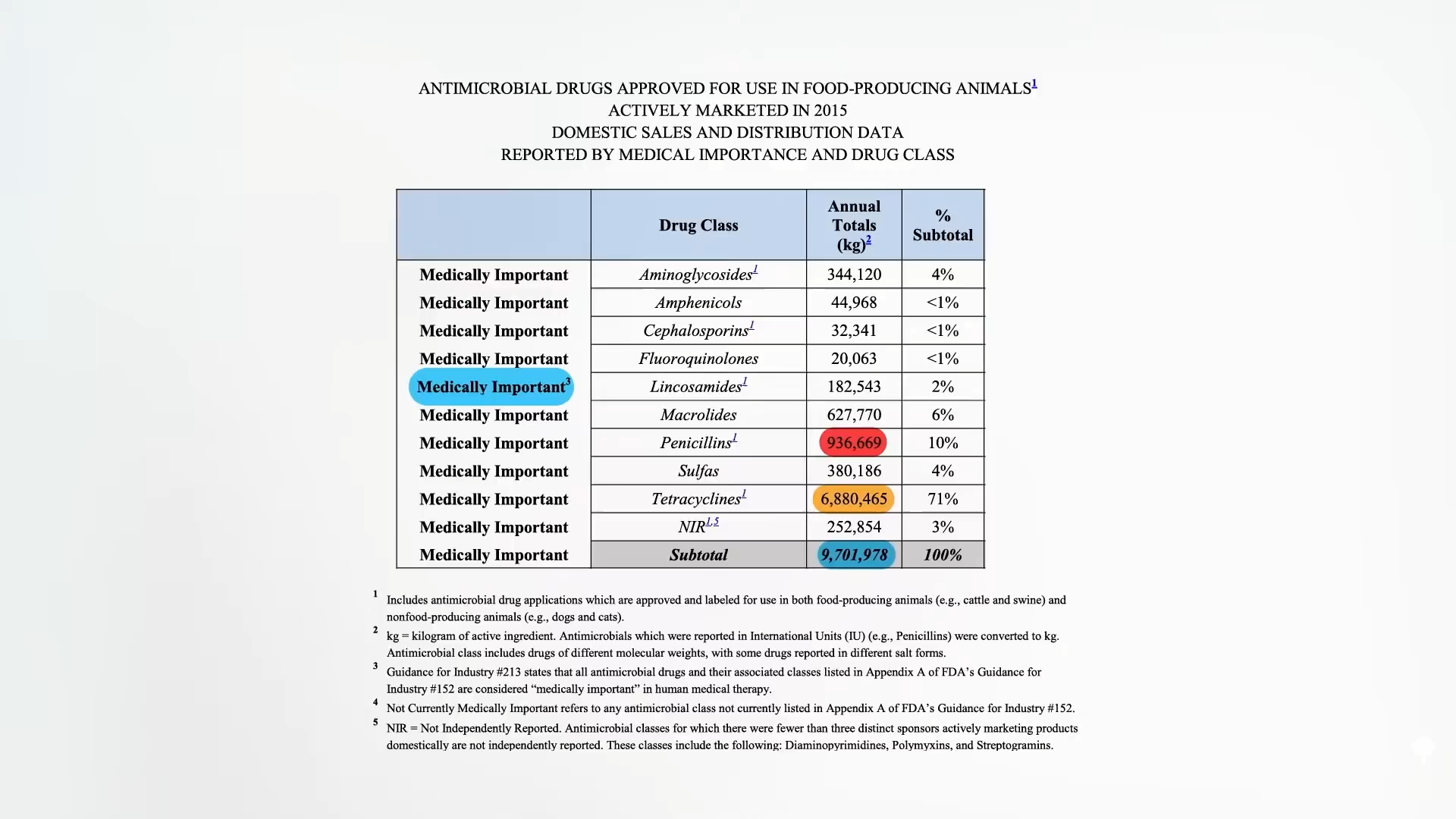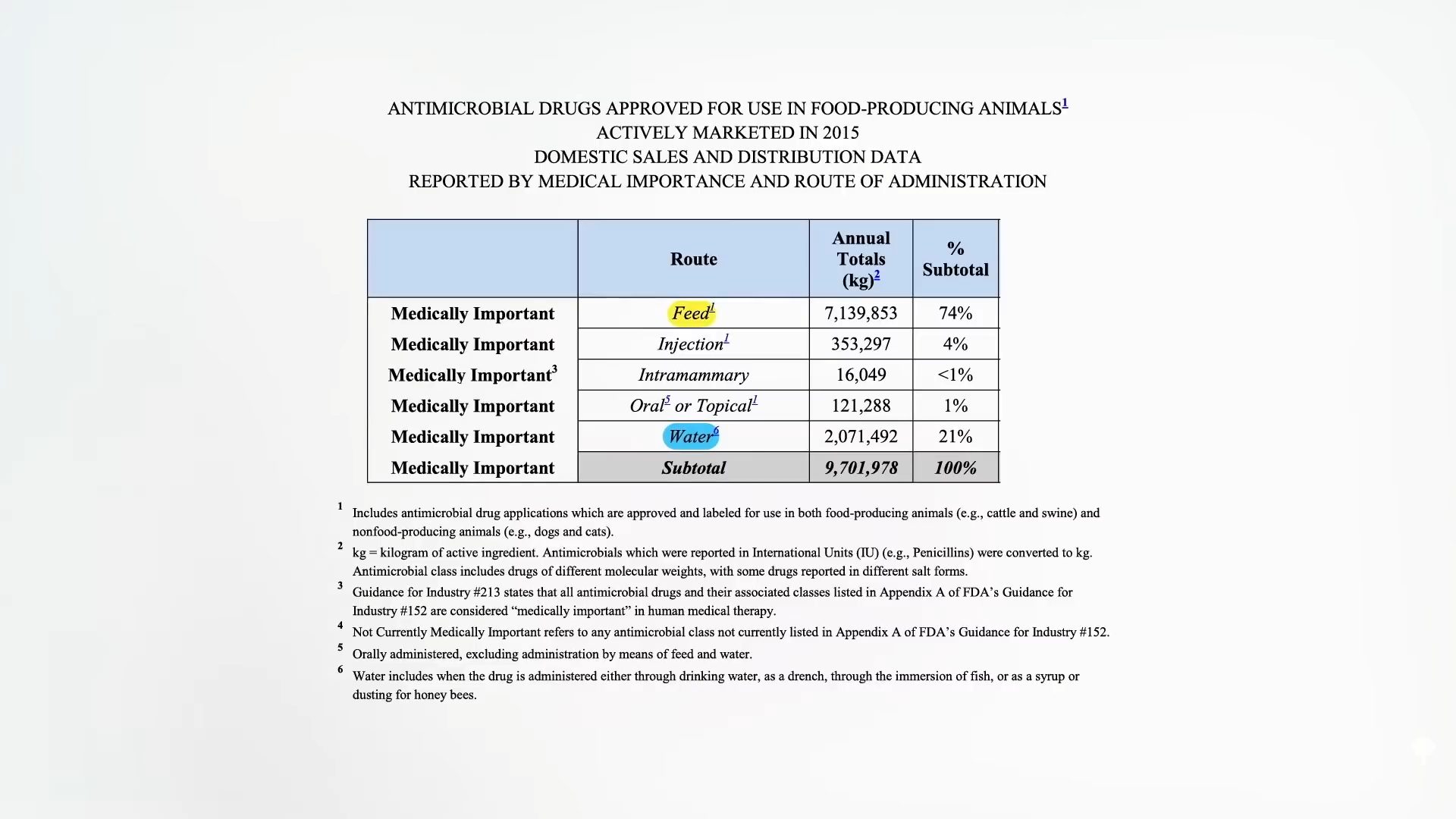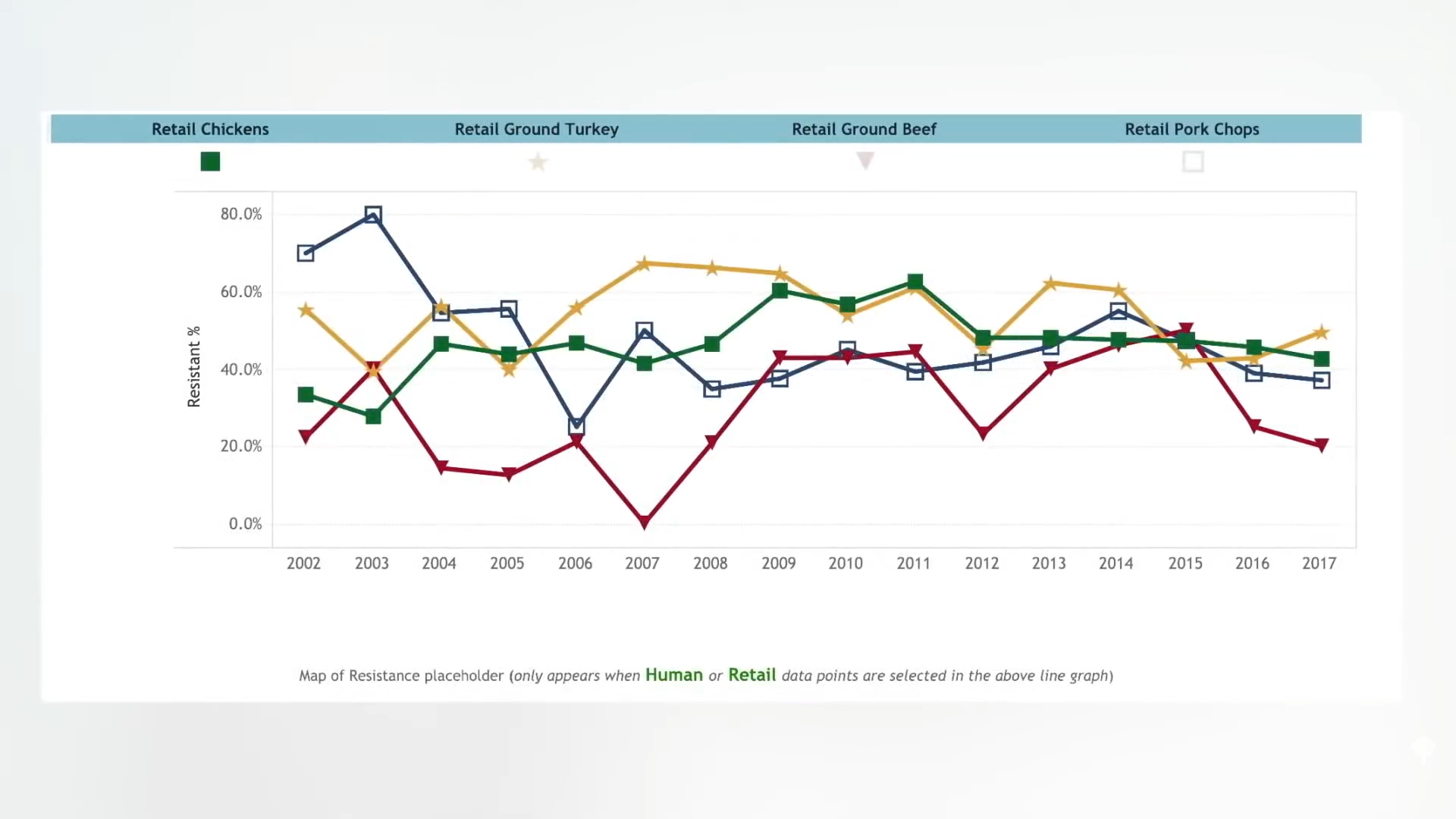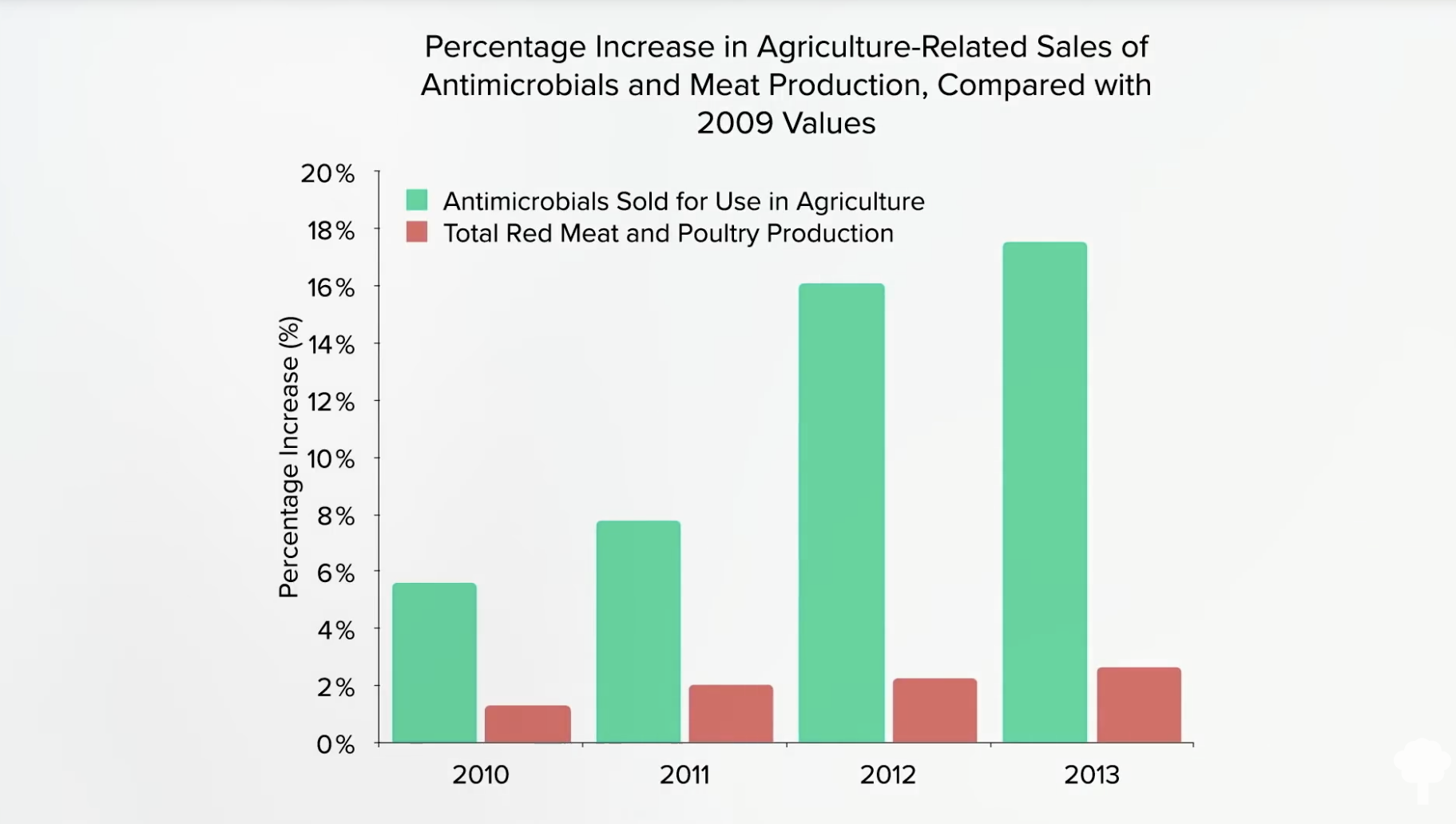Medically necessary antibiotics are being squandered by animal agriculture to compensate for typical manufacturing unit farming practices.
Cultivating muscle meat instantly from cells as an alternative of elevating and slaughtering animals would reduce the danger of foodborne diseases “on account of fecal contamination throughout slaughtering and evisceration of carcasses” as a result of there can be no feces, no slaughter, and no carcasses to eviscerate. As well as, cultivating meat would additionally scale back the risk from antibiotic resistance.
To compensate for overcrowded, nerve-racking, and unhygienic situations on manufacturing unit farms, animals are sometimes dosed en masse with antibiotics. A variety of antibiotics. About 20 million kilos of medically necessary antibiotics a 12 months, as you possibly can see right here and at 0:57 in my video, The Human Health Effects of Cultivated Meat: Antibiotic Resistance.

In the USA, for instance, livestock are given about 2 million kilos of penicillin medication and 15 million kilos of tetracyclines yearly. That is insanity.
Antibiotic medication necessary to human drugs go proper into the feed and water of animals like cows, pigs, and chickens, by the ton and by the 1000’s of tons, as proven beneath and at 1:02 in my video. And that is all and not using a prescription.

Ninety-seven p.c of the tens of thousands and thousands of kilos of antibiotics given to livestock in the USA are purchased over-the-counter—and not using a prescription and even an order from a veterinarian, as seen right here and a 1:24. To get even a couple of milligrams of penicillin, we’d like a health care provider’s prescription, as a result of these are miracle surprise medication that may’t be squandered. In the meantime, farmers can simply again their vans as much as the feedstore.

Now, half the Salmonella in retail meat—hen, turkey, beef, and pork—is proof against tetracycline, as proven beneath and at 1:50 in my video. A few quarter of the bugs are now resistant to 3 or extra whole courses of antibiotics, together with some proof against “cephalosporins akin to ceftriaxone [which] are critically necessary medication we use to deal with extreme Salmonella infections, particularly in kids.”

Such agricultural purposes for antimicrobials at the moment are considered an “pressing risk to human well being.” “The hyperlink between antibiotic use in animals and antibiotic resistance in people is unequivocal.”
As proven right here and at 2:20 in my video, all of it begins with the poop.

Antibiotic-resistant bugs are chosen for after which can unfold by way of meat or produce contaminated by poop or they will spread via the wind, the air, or the water, or be carried by bugs. There are various pathways by which resistant superbugs can escape. So, even in case you don’t eat meat, you might be “put in danger by the pathogens launched from pressured, immunocompromised, contaminant-filled livestock” dosed with antibiotics. That’s one of many causes the American Public Well being Affiliation called for a moratorium on manufacturing unit farms, due partially to all of the air pollution from concentrated animal feed operations (CAFOs) to the encompassing communities.
Yearly, greater than five tons of animal manure are produced for each man, lady, and little one in the USA. Once more, all of it starts with the poop. However cultivated meat means no guts, no poop, no fecal infections, and no antibiotics obligatory. It additionally means no fecal or antibiotic residues left in “foodstuffs akin to milk, egg, and meat” that may doubtlessly trigger a wide range of facet effects past simply the switch of antibiotic-resistant micro organism to people.
And, as you possibly can see right here and at 3:30 in my video, issues are getting worse, not higher. U.S. animal agriculture is utilizing extra antibiotics now than ever.

This isn’t solely as a result of extra animals are being raised for meals, both. Antibiotic gross sales in the USA are outpacing meat manufacturing. Sure, meat manufacturing goes up, however there’s a severe rise in antibiotic gross sales for meat manufacturing, as proven beneath and at 3:46.

With the mixed may of Huge Ag and Huge Pharma (who revenue from promoting all of the medication), it’s onerous to think about something altering on the political facet. The one hope could also be a change within the manufacturing facet.
“The unstoppable rise of super-resistant strains of micro organism is a severe worldwide drawback, leading to 700 000 deaths yearly,” and the projections for international antibiotic use within the manufacturing of livestock are “ominous,” estimated to exceed 100,000 tons of antibiotics pumped into animals raised for meals by 2030. Fairly merely, we may be “on the trail to untreatable infections” by utilizing even a few of our “final resort antibiotics,” like carbapenems, simply to shave a couple of cents off a pound of meat.
And it’s not simply foodborne micro organism. Mad cow illness, swine flu, and hen flu have the potential to kill thousands and thousands of individuals. Skeptical? I’ve obtained a ebook so that you can learn, whose writer’s “very good storytelling capacity makes each web page of the ebook fascinating and interesting for each specialist and layperson.” (Thanks, Virology Journal, for the fantastic ebook overview and calling my ebook “a should learn.”)
Given the specter of the chickens coming residence to roost, an editorial within the American Journal of Public Well being thought that “it’s curious, subsequently, that altering the best way people deal with animals—most mainly, ceasing to eat them or, on the very least, radically limiting the amount of them which might be eaten—is basically off the radar as a major preventative measure. Such a change, if sufficiently adopted or imposed, might nonetheless scale back the possibilities of the much-feared influenza epidemic…But humanity doesn’t take into account this selection.”
Which may be moot, although, as a result of we might domesticate all of the hen we would like, with out guts or lungs.
It’s onerous to emphasize the significance of that American Journal of Public Well being editorial. As devastating as COVID-19 has been, it could simply be a costume rehearsal for a good larger risk ready within the wings—the wings of chickens.
In line with the Facilities for Illness Management and Prevention, the main candidate for the following pandemic is a hen flu virus often called H7N9, which is 100 occasions deadlier than COVID-19. As a substitute of 1 in 250 sufferers dying, H7N9 has killed 40 p.c of the individuals it infects.
The final time a hen flu virus jumped on to people and prompted a pandemic, it triggered the deadliest plague in human historical past—the 1918 pandemic that killed 50 million individuals. That had a 2 p.c loss of life fee. What if we had a pandemic infecting billions the place loss of life was nearer to a flip of a coin?
The excellent news is that there’s something we are able to do about it. Simply as eliminating the unique animal commerce and reside animal markets might go a great distance towards stopping the following coronavirus pandemic, reforming the best way we elevate home animals for meals might assist forestall the following killer flu. The underside line is that it’s not price risking the lives of thousands and thousands of individuals for the sake of cheaper hen.
Should you missed the earlier video, see The Human Health Effects of Cultivated Meat: Food Safety. Up subsequent is The Human Health Effects of Cultivated Meat: Chemical Safety.











